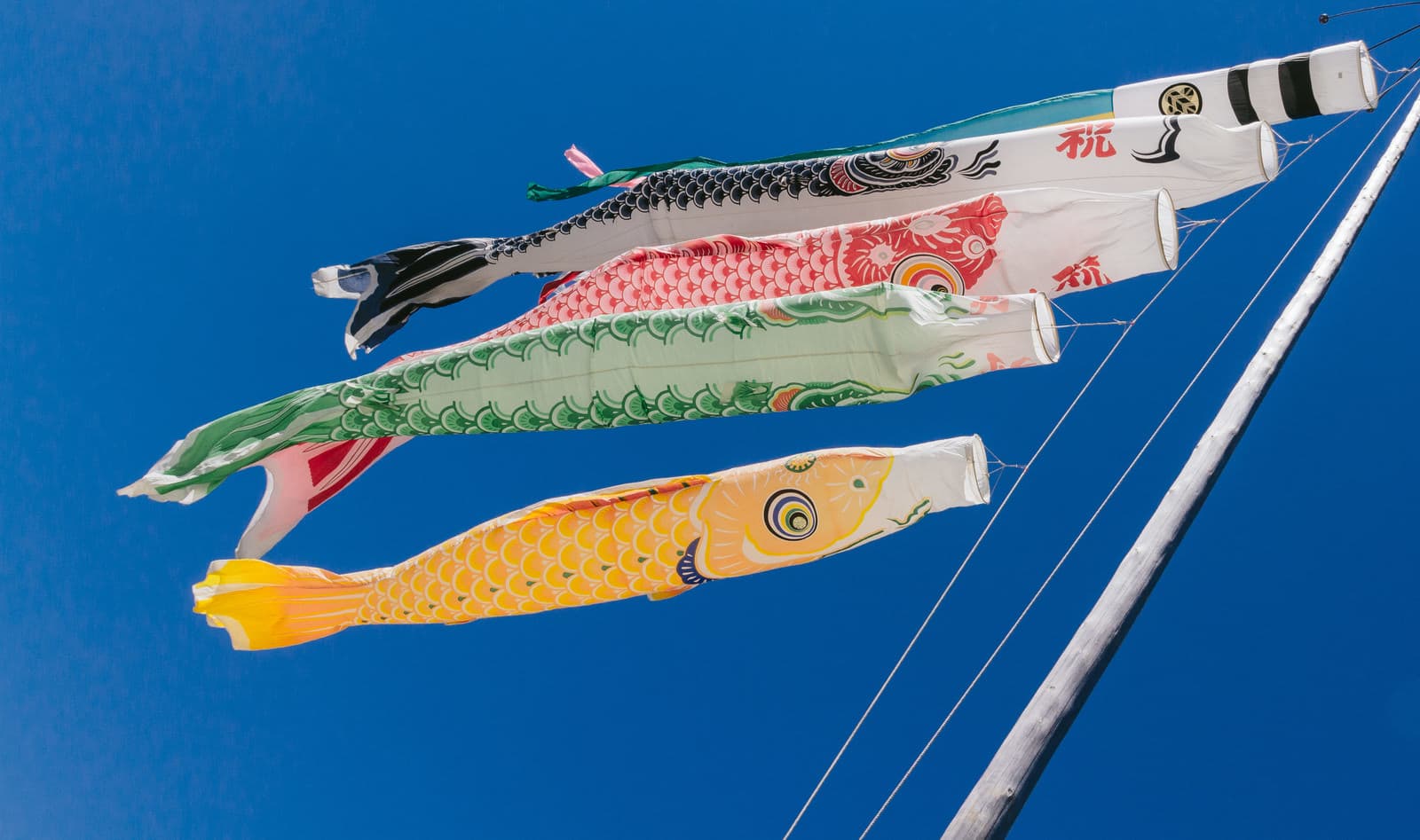Introduction: When Carp Streamers Swim Across the Sky
In early May, the blue sky above Japan fills with colorful koinobori (鯉のぼり)—carp-shaped streamers that flutter in the wind.
They swim gracefully above rooftops and rivers, announcing the arrival of early summer.
Families display them to celebrate their children’s health, happiness, and growth.
May 5 is known as Kodomo no Hi (こどもの日), or Children’s Day.
It falls within Japan’s Golden Week holidays, a time when families gather and cities are alive with festivity.
But before it became a modern national holiday, this day was originally known as Tango no Sekku (端午の節句), a traditional festival for boys.
Over time, it evolved into a day for all children—celebrating not only strength, but also gentleness and the hope for a bright future.
From Ancient Ritual to Samurai Tradition
The origins of Kodomo no Hi trace back to ancient China, where people celebrated the fifth day of the fifth lunar month as a time to ward off evil spirits and illness.
The word tango (端午) originally meant “the first day of the horse,” but later came to mean the fifth day of the fifth month.
In China, it was customary to hang iris and mugwort leaves for purification and to drink herbal sake for protection.
When this custom reached Japan, the iris (菖蒲, shōbu)—whose name sounds like shōbu meaning “victory” or “battle”—was linked to the warrior spirit.
By the Heian period (8th–12th centuries), nobles decorated their homes with iris leaves to drive away misfortune.
Later, during the Kamakura and Muromachi periods, the samurai class adopted the festival as a way to celebrate boys’ courage and wish for their success.
What began as a purification ritual became a celebration of growth, bravery, and protection for the next generation.
From “Boys’ Festival” to “Children’s Day”
During the Edo period (17th–19th centuries), Tango no Sekku flourished as one of the major annual events in samurai households.
Families displayed miniature armor and helmets (鎧・兜, yoroi and kabuto) inside their homes to symbolize strength and protection.
Outside, tall banners and paper carp streamers decorated the rooftops, proudly announcing the birth of a son.
As time went on, the celebration spread among common people as well, transforming from a noble ritual into a joyful family event.
After World War II, Japan redefined the meaning of the day.
In 1948, the government officially established Kodomo no Hi as a national holiday under the new Public Holiday Law.
Its purpose was to “respect children’s personalities, celebrate their happiness, and express gratitude toward mothers.”
Thus, May 5 became a day to honor all children—boys and girls alike, as well as the families who nurture them.
Symbols and Their Meanings
Koinobori (鯉のぼり) – Carp Streamers
The carp is known for its determination and strength, able to swim upstream against strong currents.
According to a Chinese legend, a carp that climbs the waterfall of the Dragon Gate becomes a dragon—a symbol of perseverance and success.
Families raise koinobori to express the wish that their children will grow up strong and overcome life’s challenges.
Traditionally, the top black carp represents the father, the red one the mother, and the smaller, colorful carps the children.
Today, you can find modern versions with vibrant designs or compact indoor sets for urban apartments.
Kabuto and Yoroi (兜・鎧) – Helmets and Armor
These symbolize not war, but protection.
Parents display them to guard children from harm and illness, much like ancient amulets.
They embody the samurai spirit of courage and care—the idea that true strength protects, not destroys.
Shōbu-yu (菖蒲湯) – Iris Bath
On the evening of May 5, many families take a bath scented with iris leaves.
The plant’s fragrance is believed to drive away evil spirits and promote good health.
Even today, iris baths remain a soothing reminder of seasonal renewal and wellness.
Kashiwa-mochi (柏餅) and Chimaki (ちまき)
These traditional sweets also carry symbolic meanings.
Kashiwa-mochi, rice cakes wrapped in oak leaves, represent family continuity, since oak trees do not shed old leaves until new ones grow.
Chimaki, glutinous rice wrapped in bamboo leaves, originated from Chinese customs and is eaten to ward off misfortune.
Together, these customs form a rich tapestry of love, protection, and hope.
Modern Celebrations and Changing Traditions
Today, many Japanese families celebrate Kodomo no Hi in simple yet meaningful ways.
While fewer homes have space for large koinobori, communities and parks often organize large-scale displays of hundreds of carp swimming together in the wind—a breathtaking sight.
Schools and kindergartens hold art activities where children make paper koinobori or fold samurai helmets out of newspaper.
Shopping malls host “Children’s Festivals,” and parents share traditional sweets while talking about their kids’ dreams.
Even in busy modern life, the essence remains the same: to celebrate children’s growth and the love that supports it.
Kodomo no Hi Around the World
Beyond Japan, Kodomo no Hi has found a home in many countries with Japanese communities.
In cities like Los Angeles, São Paulo, and Vancouver, families gather to fly koinobori and share Japanese food.
Cultural centers and Japanese language schools use the day to teach children about respect, courage, and gratitude.
In anime and film, scenes of carp streamers swaying in the sky often symbolize peace, family, and nostalgia—universal emotions that transcend borders.
Kodomo no Hi has become a cultural bridge, connecting people through the shared wish for children’s happiness.
Strength and Kindness: The True Spirit of Kodomo no Hi
Kodomo no Hi is not only about raising strong children—it is about nurturing both strength and kindness.
True strength lies in protecting others.
True kindness lies in understanding others’ pain.
When combined, they create the heart of a compassionate person.
As the carp swim boldly in the wind and the scent of iris fills the air, families across Japan are reminded of something timeless:
that every child carries the hope of tomorrow.
